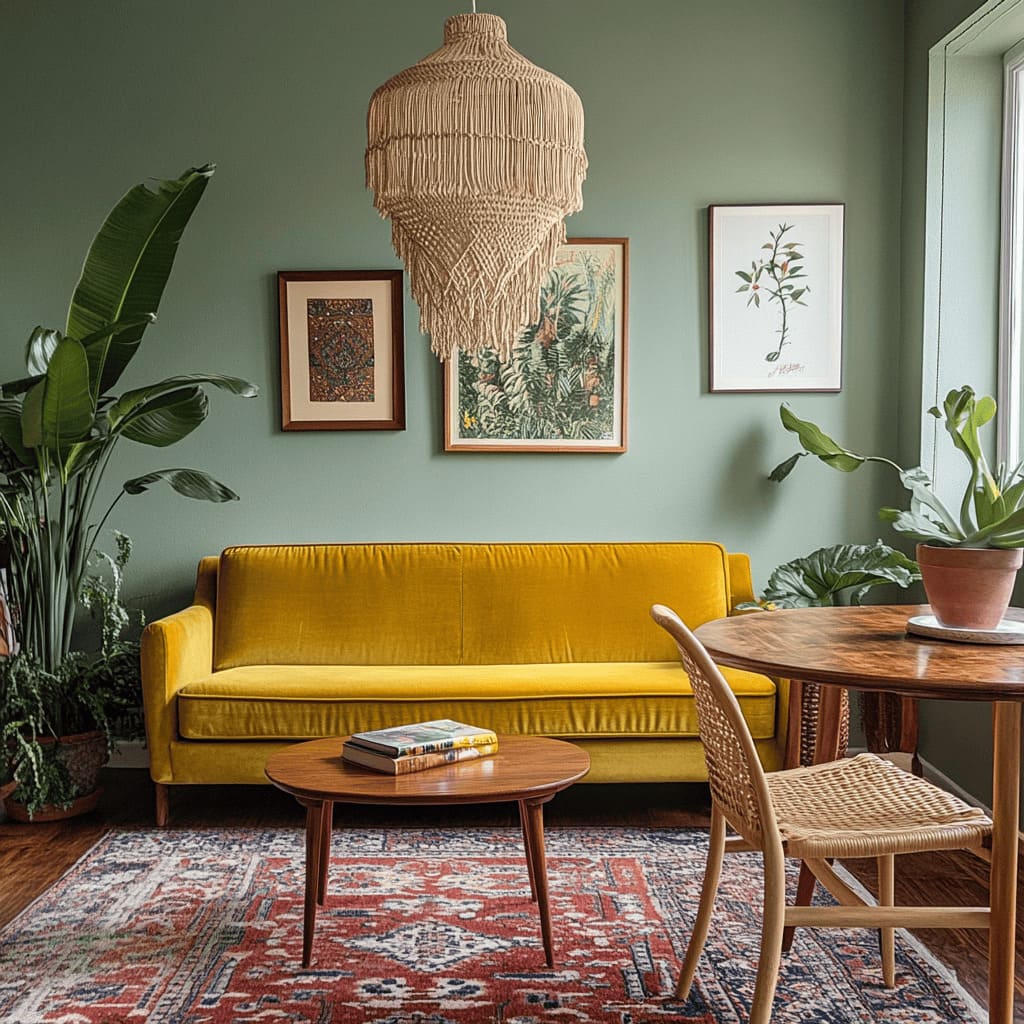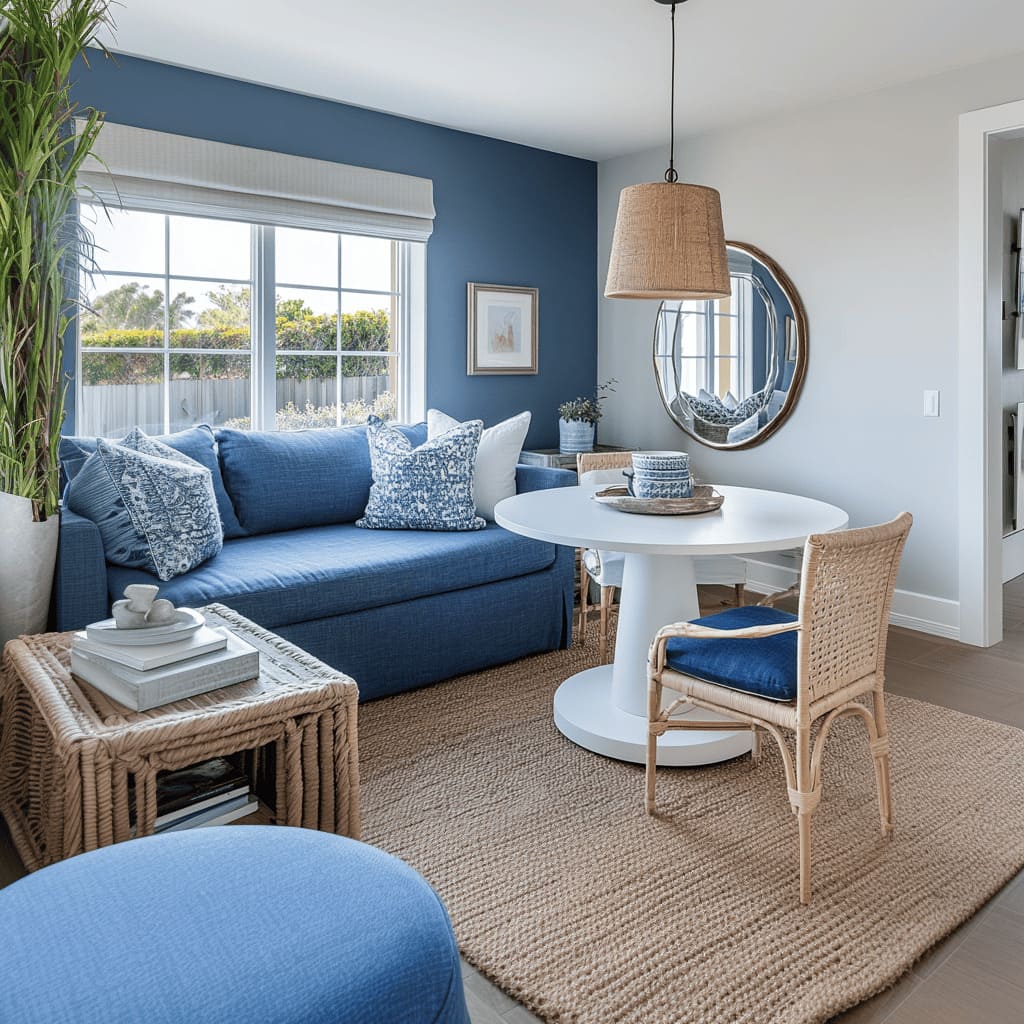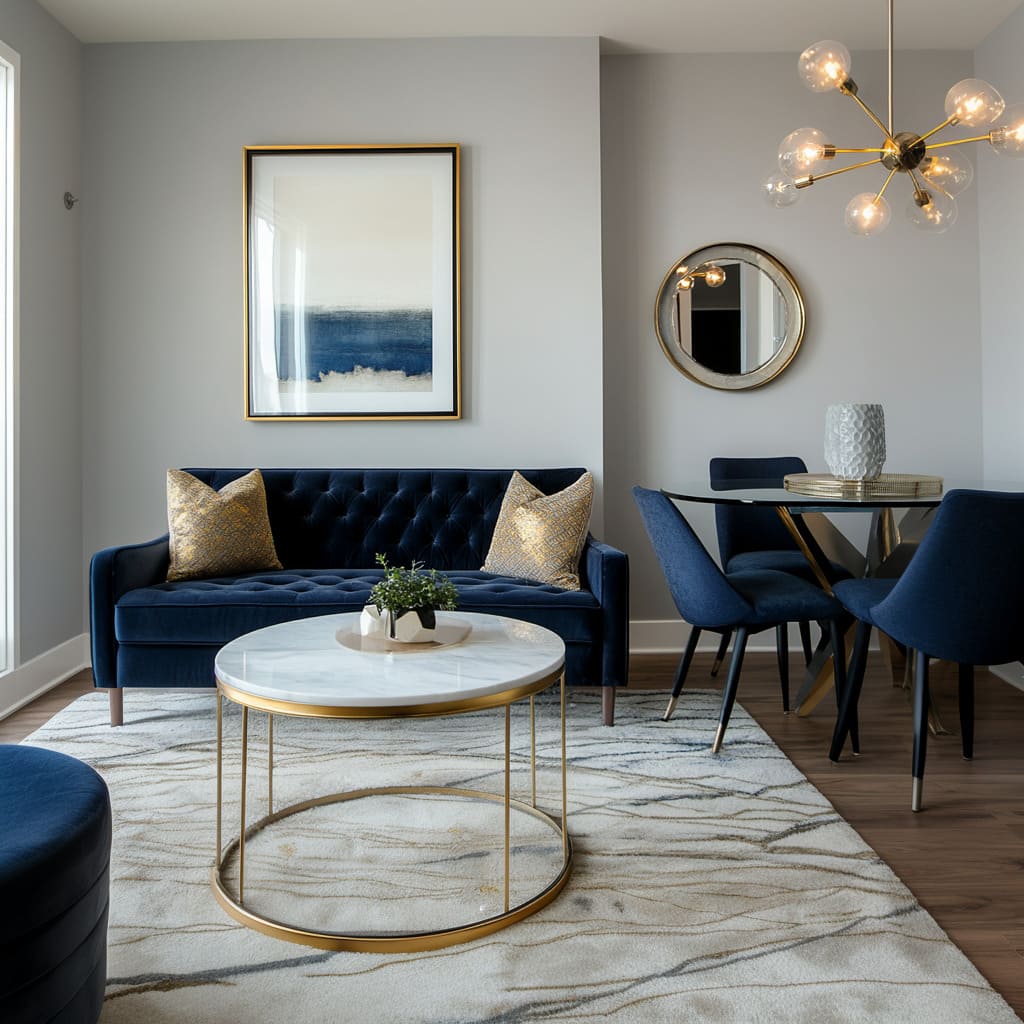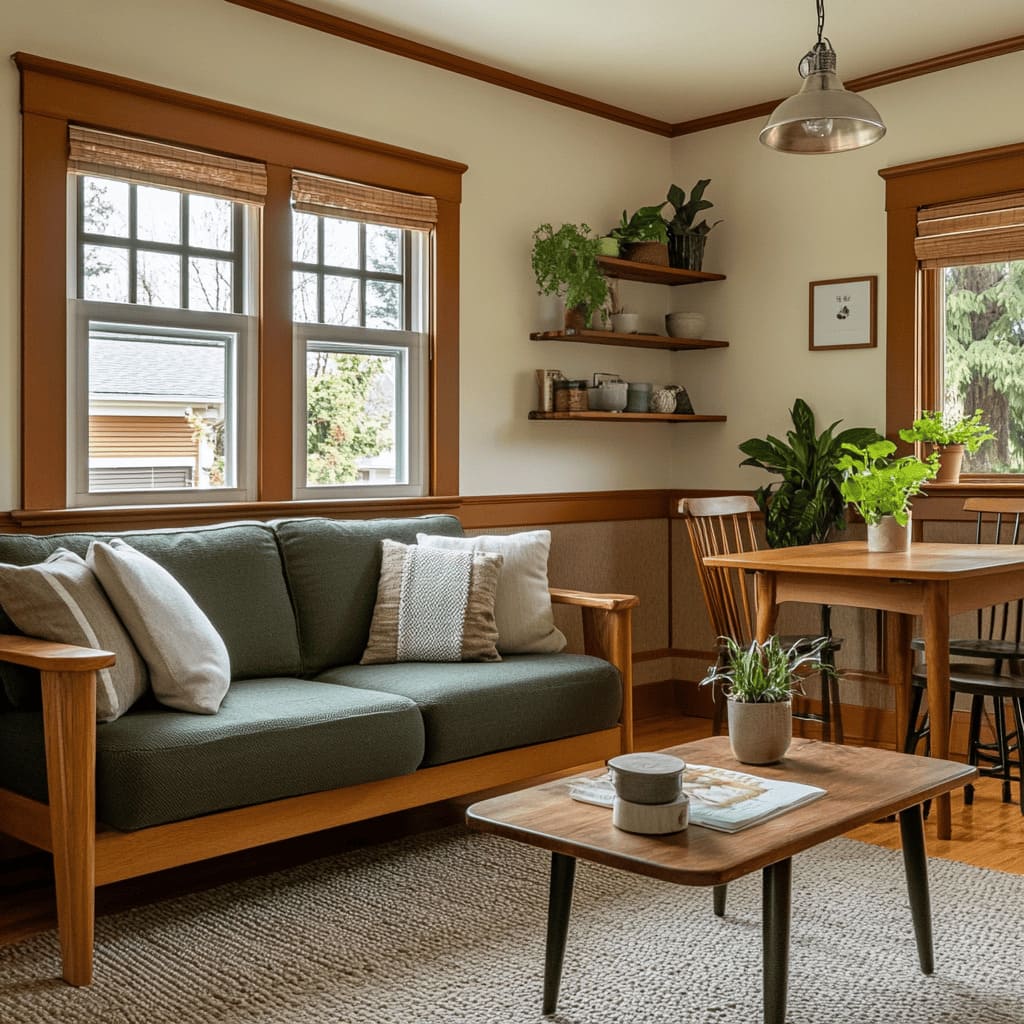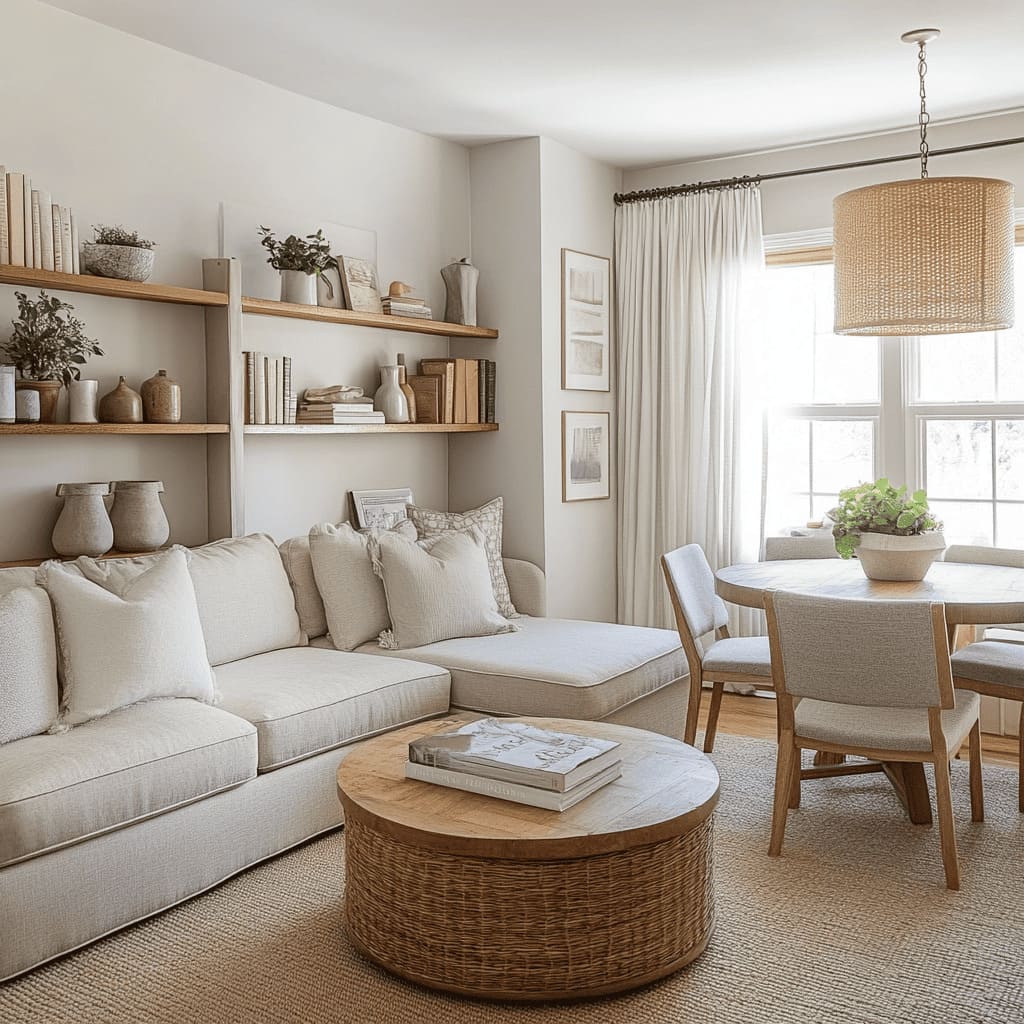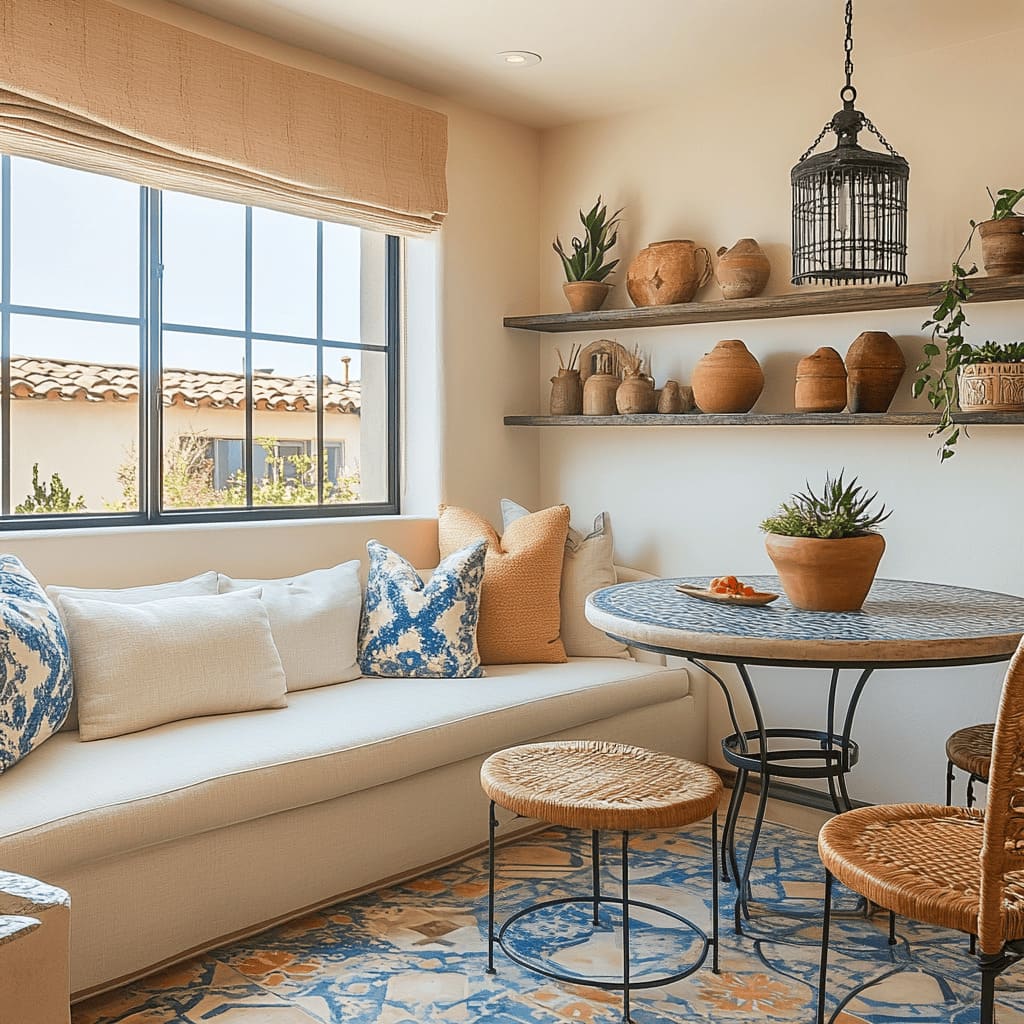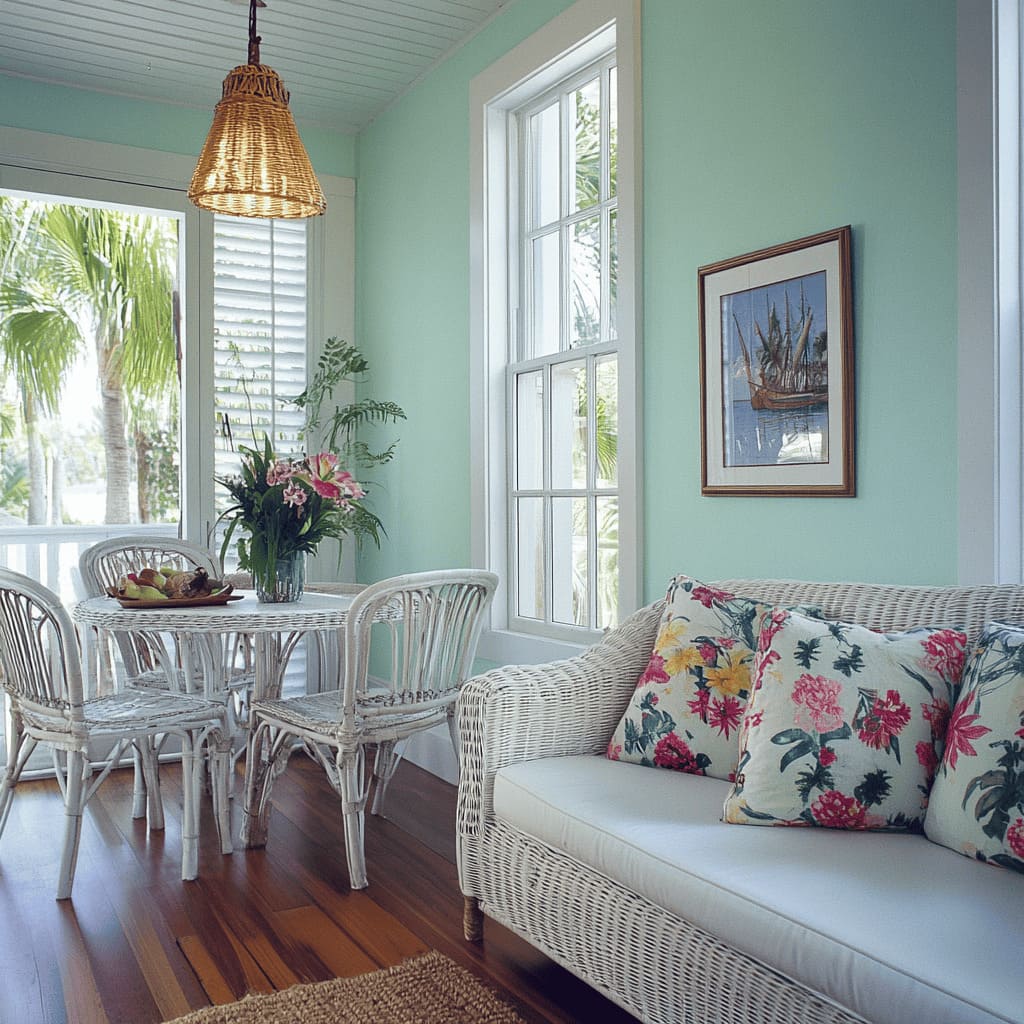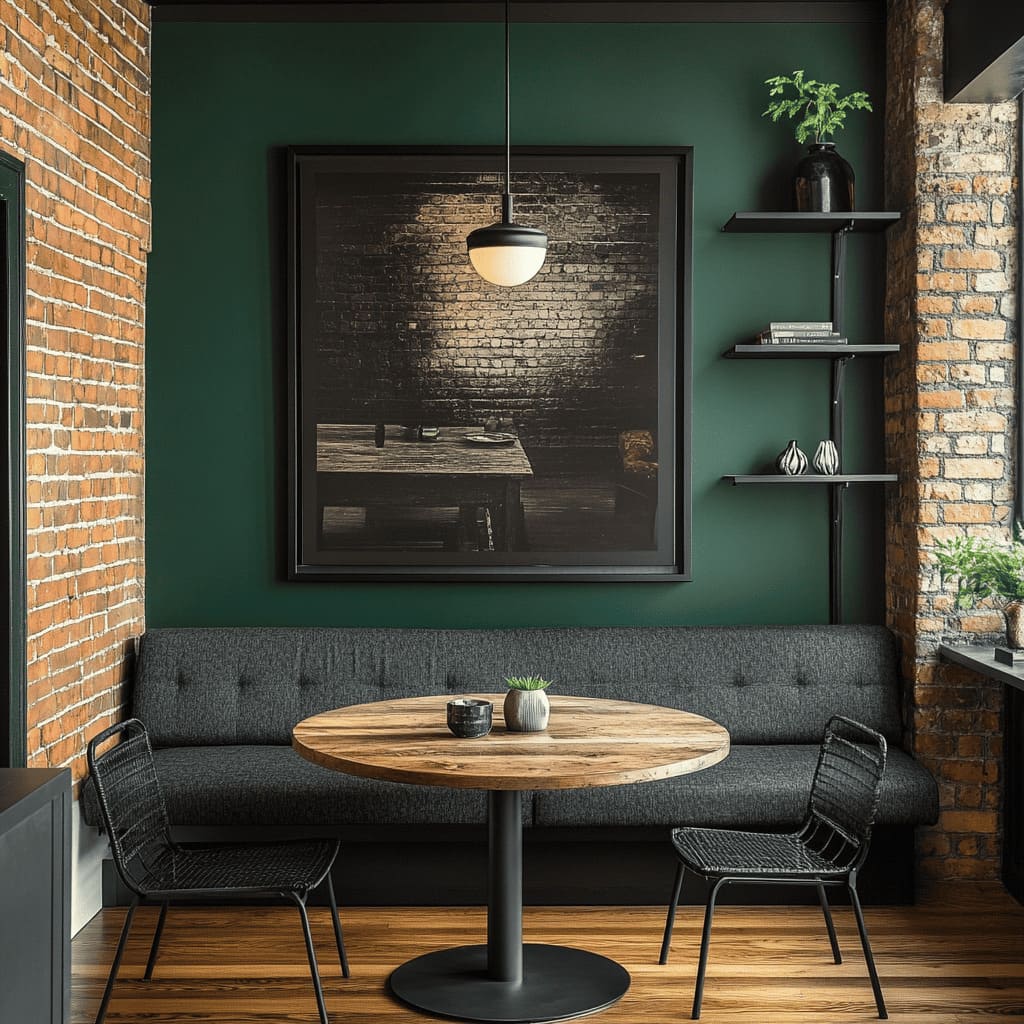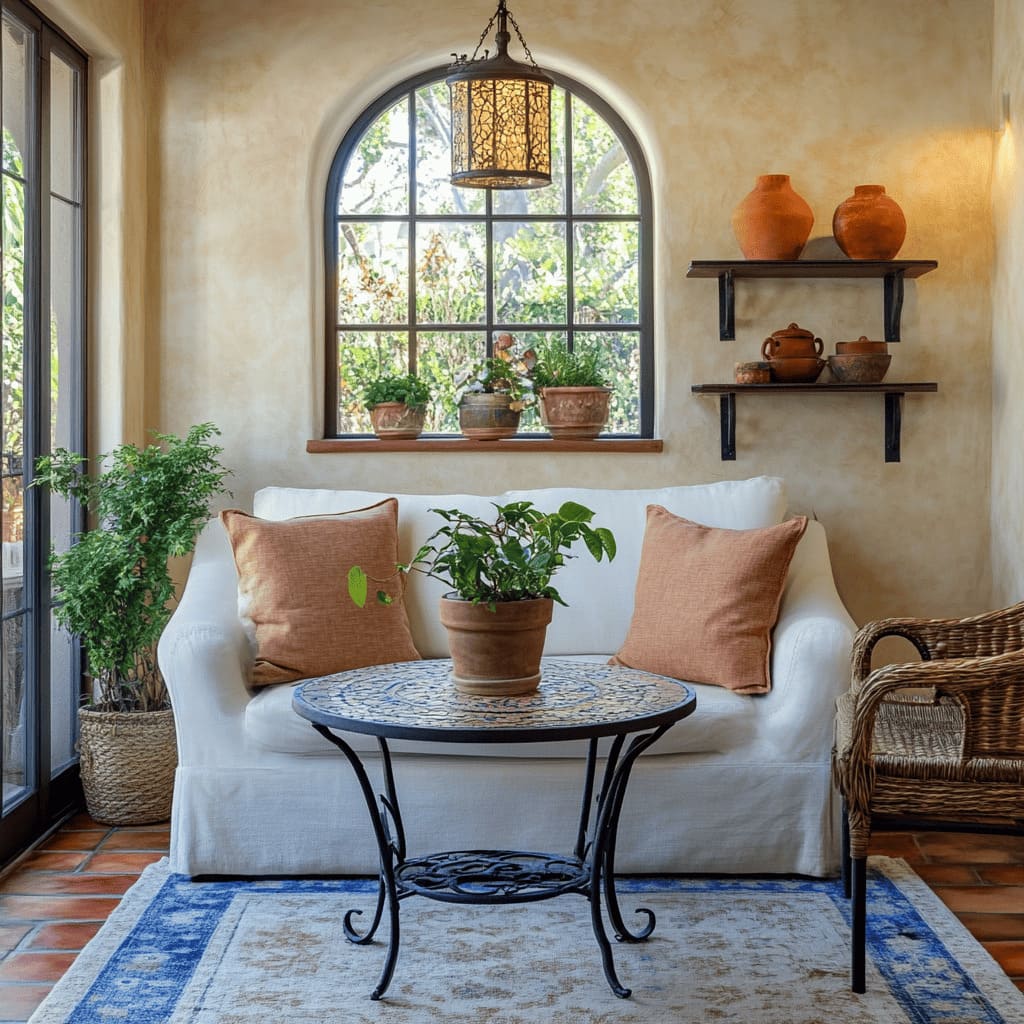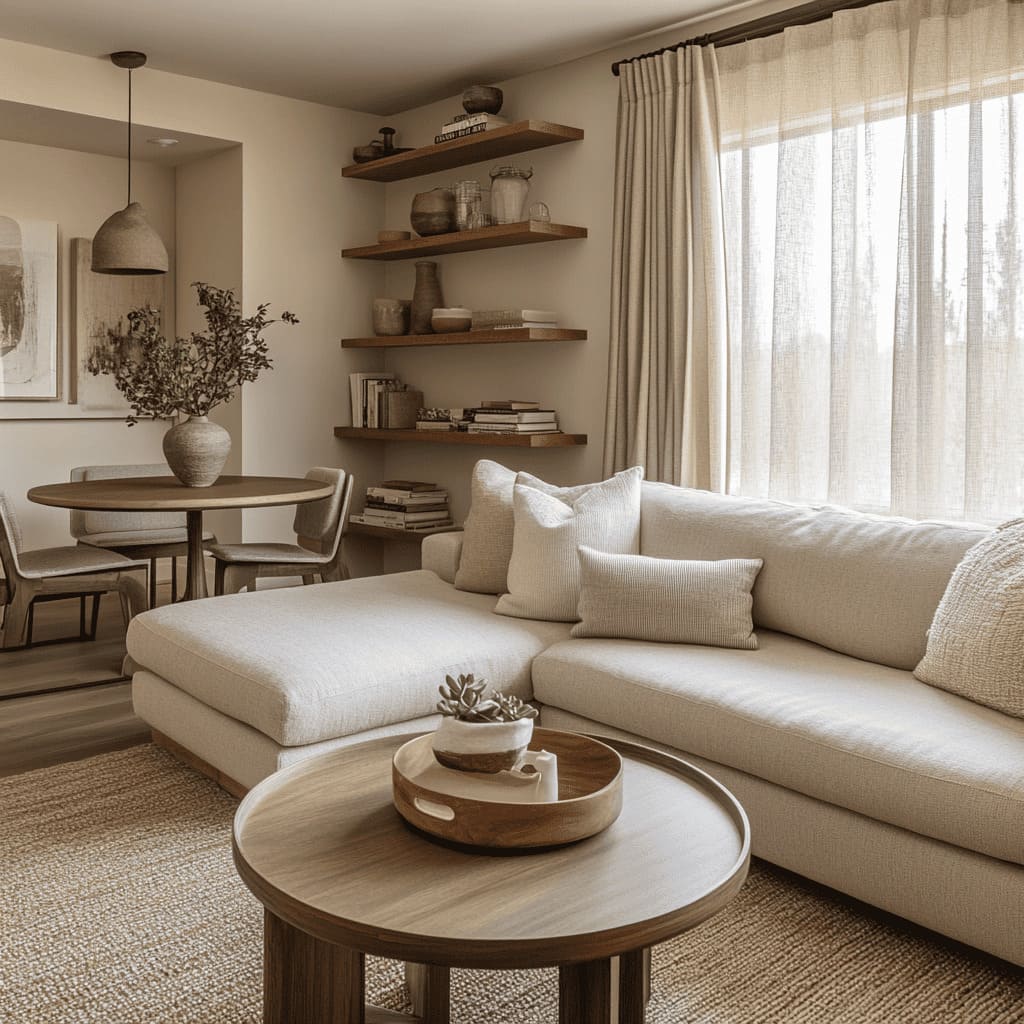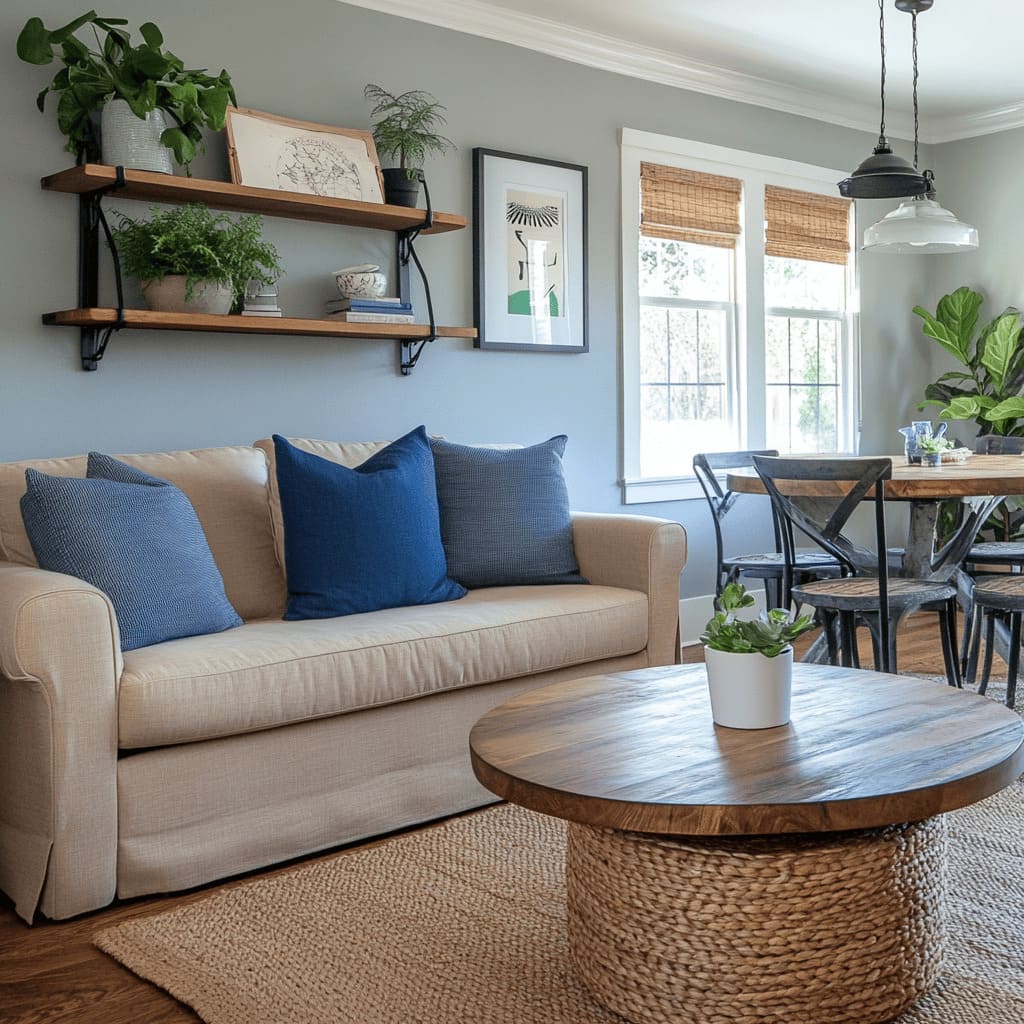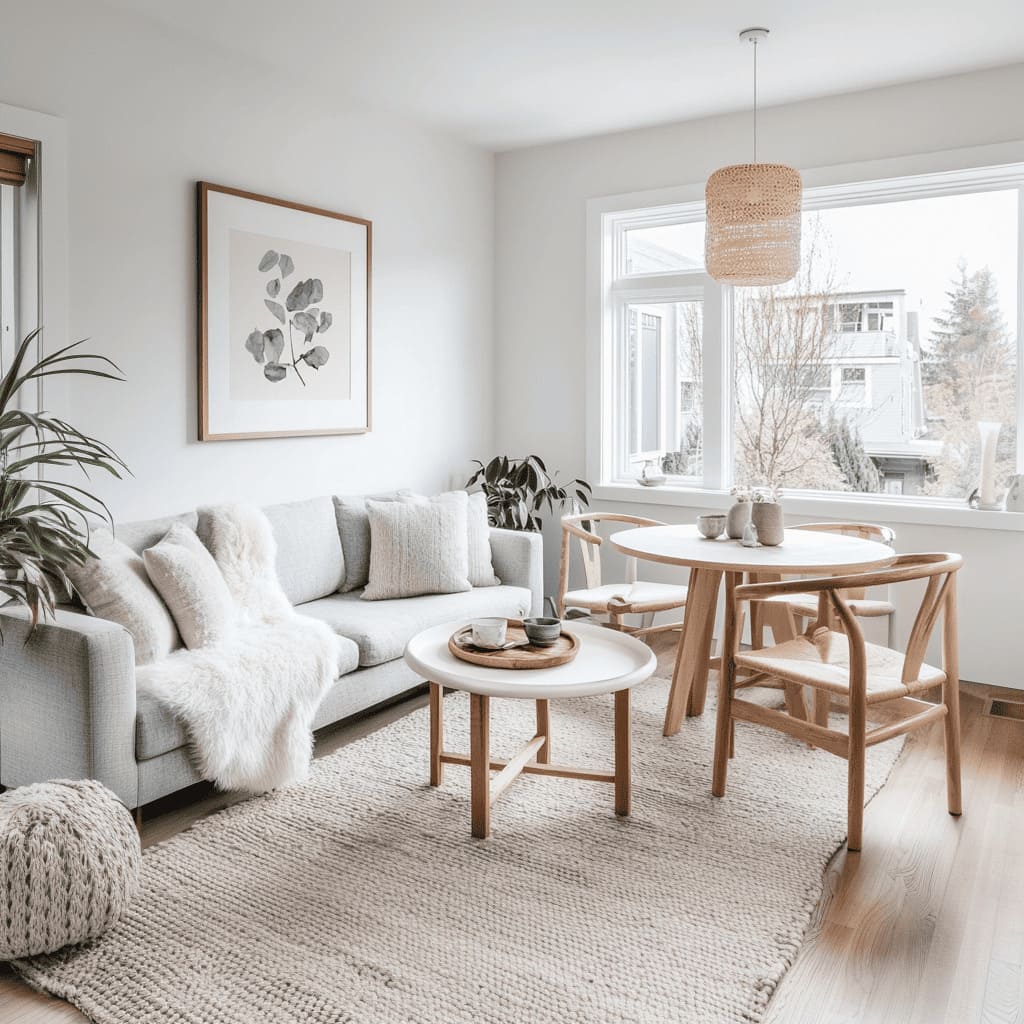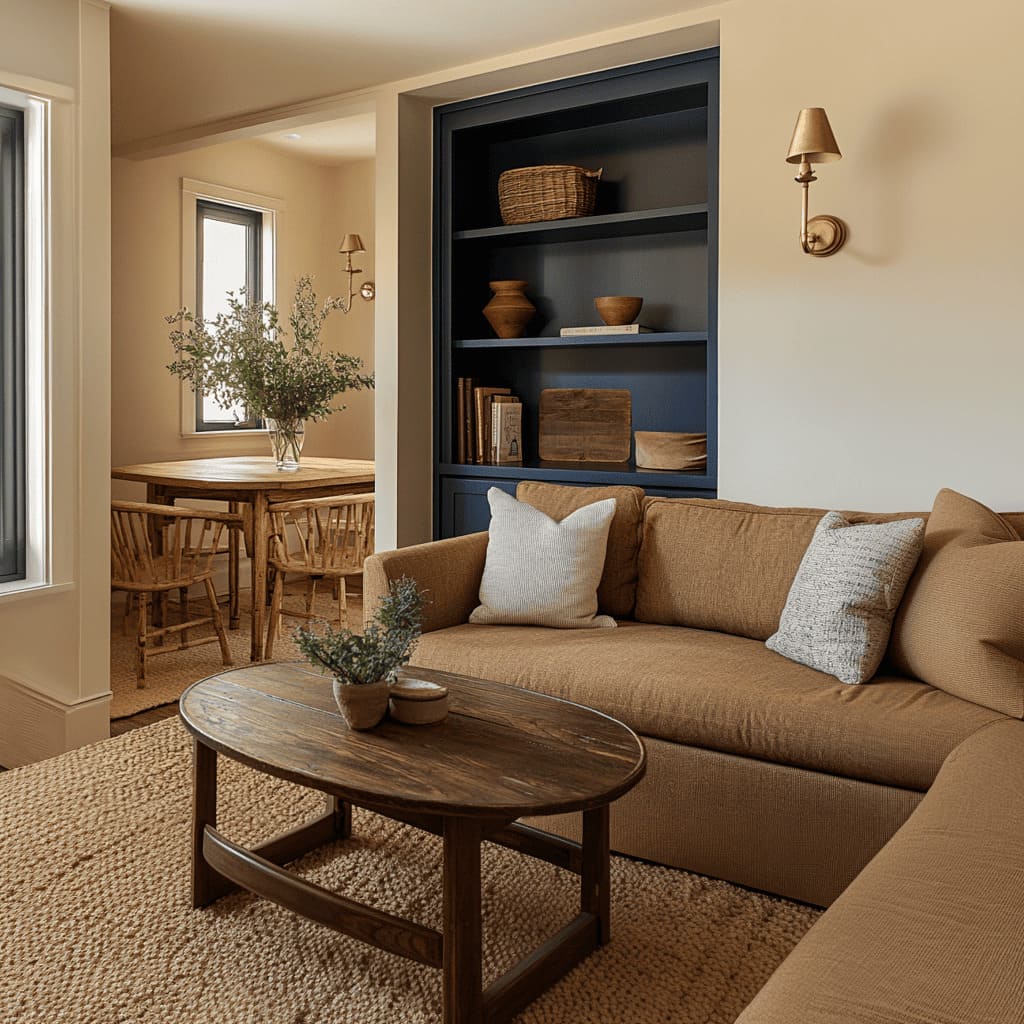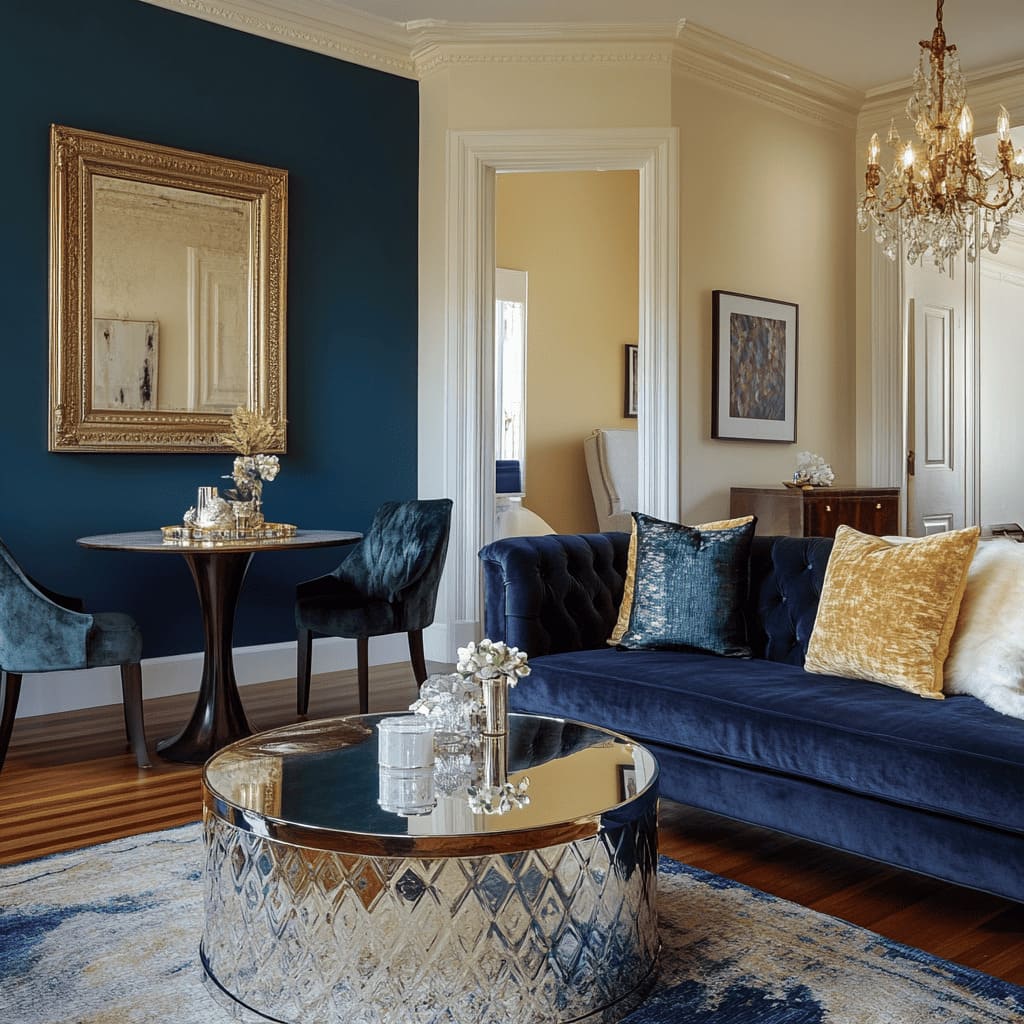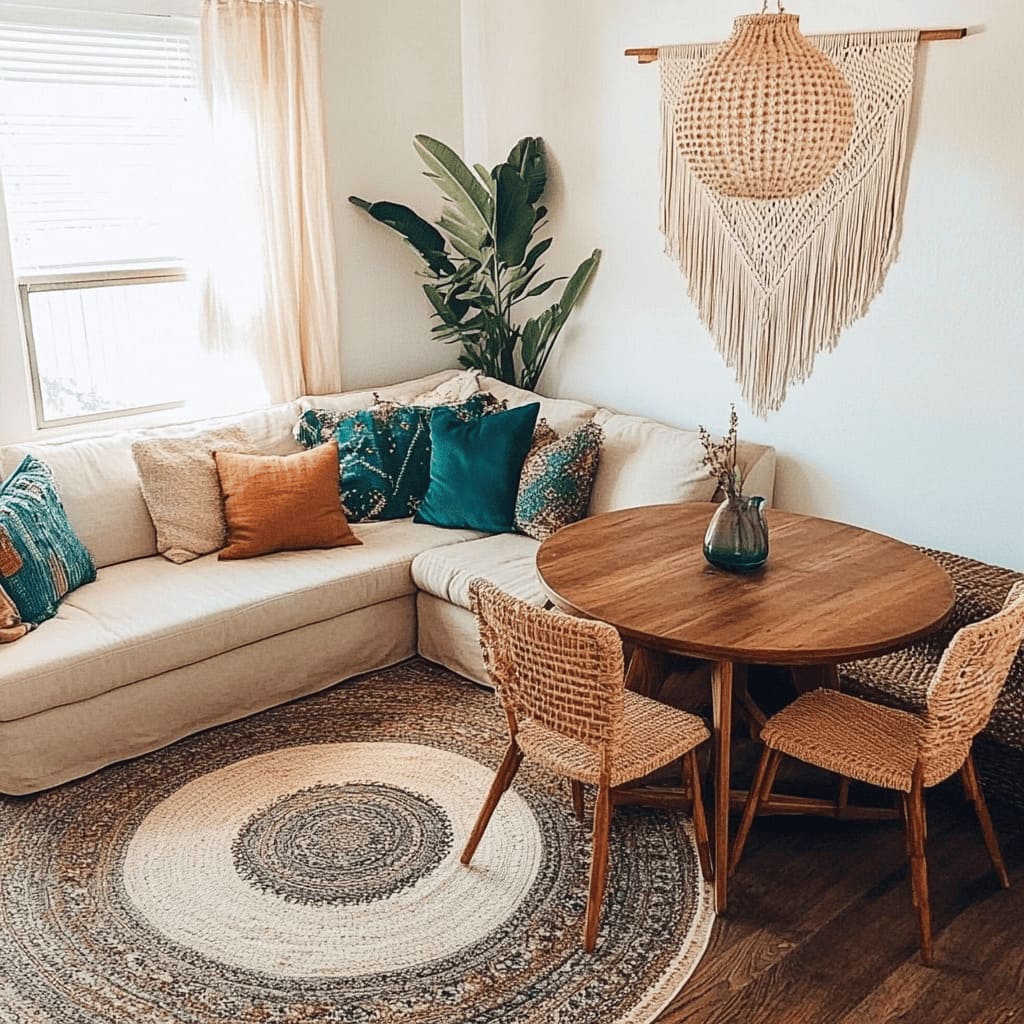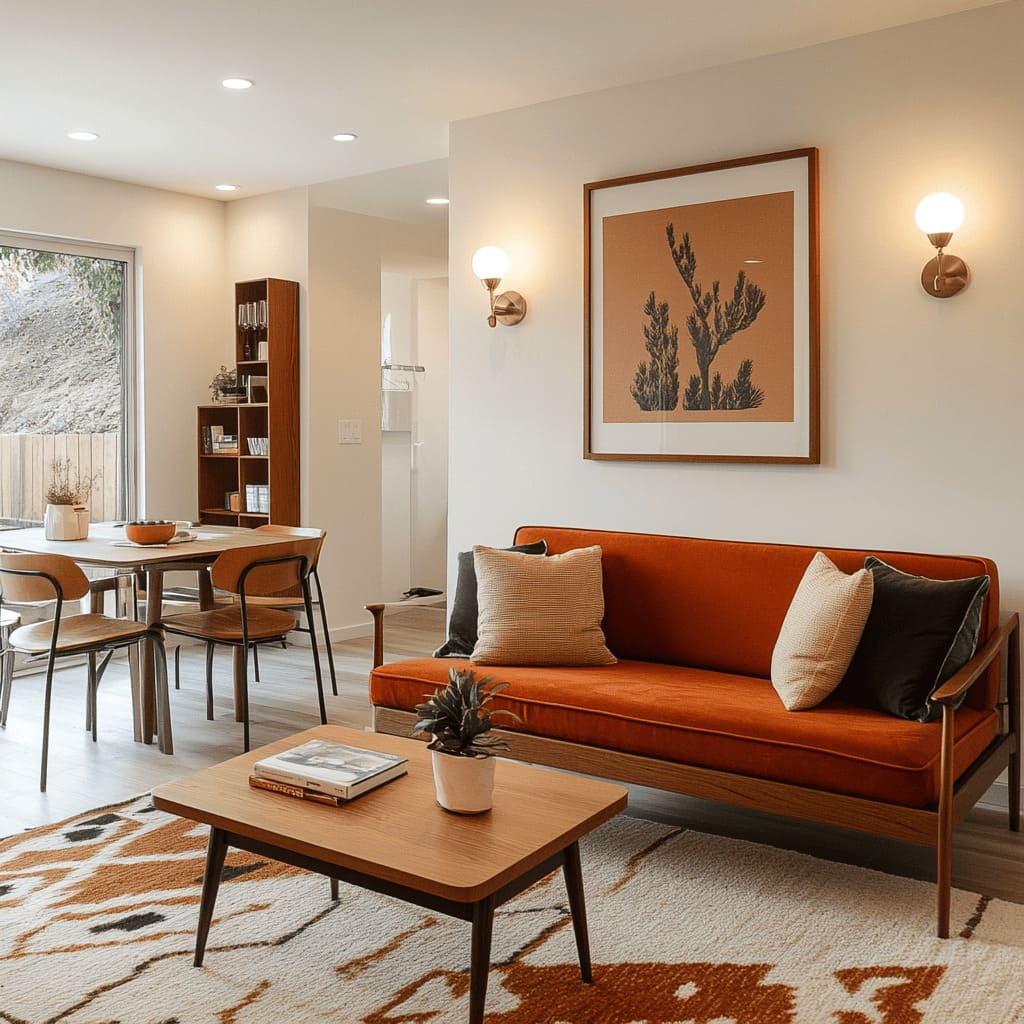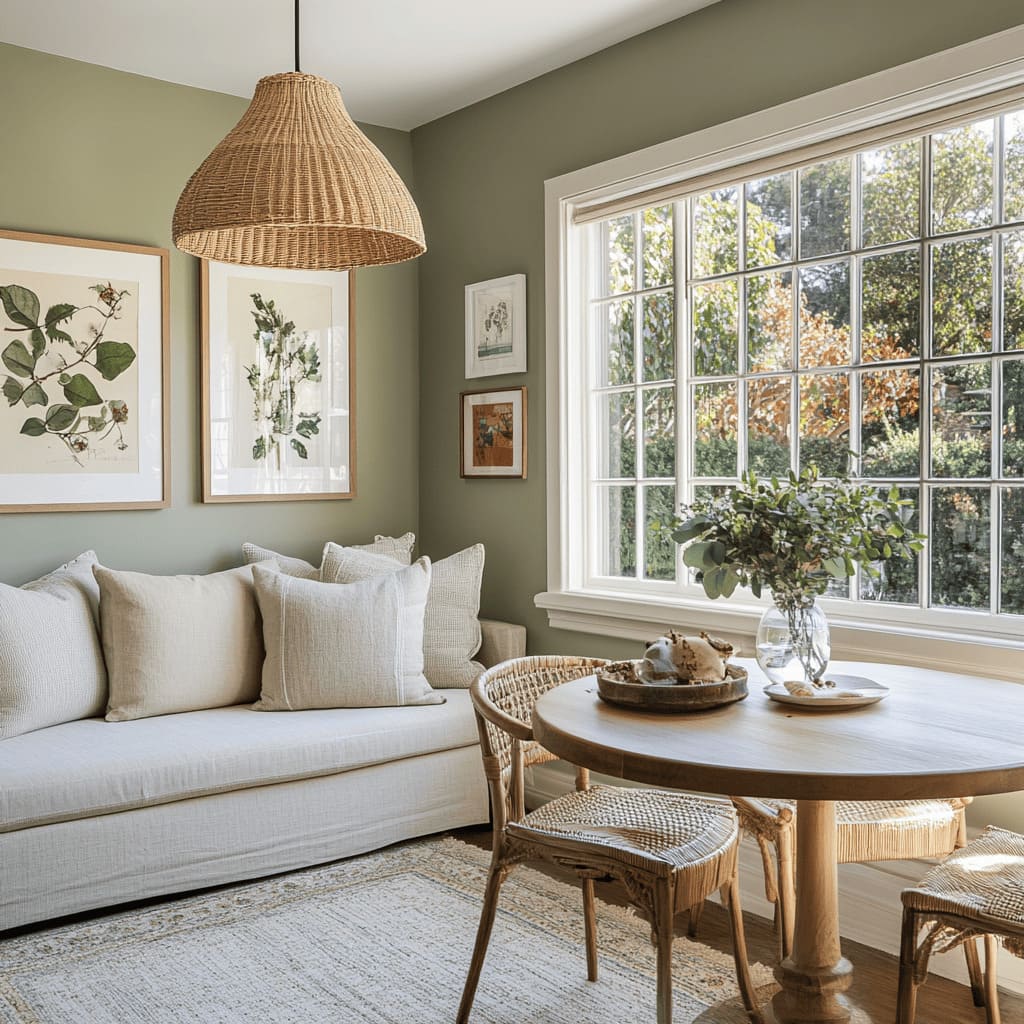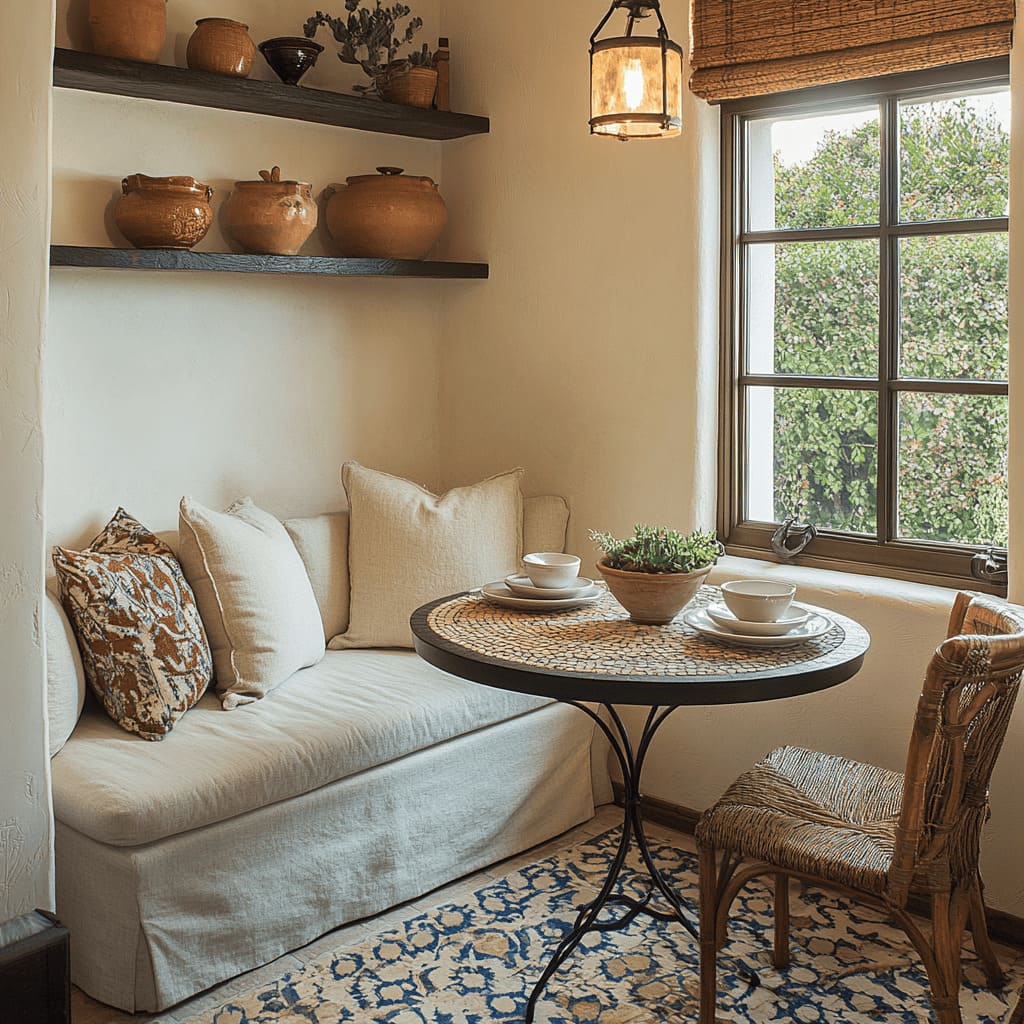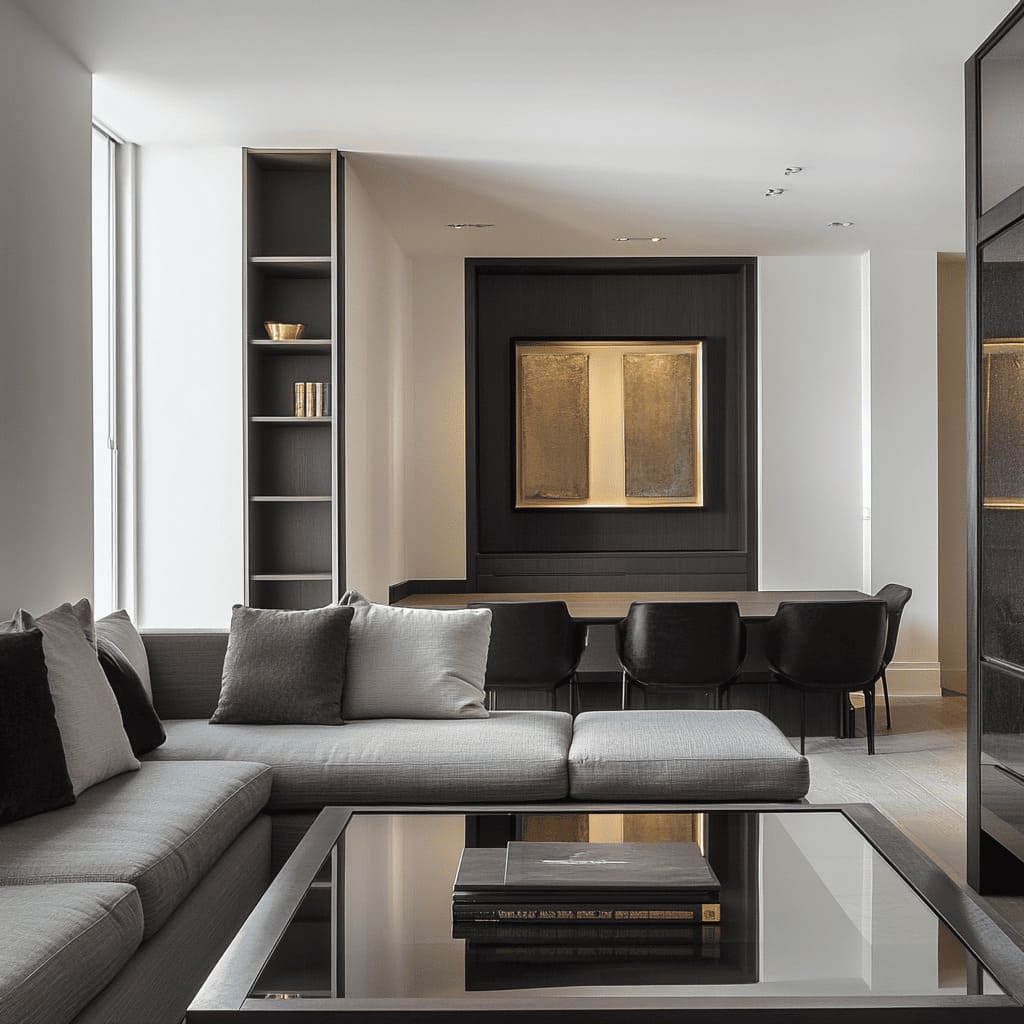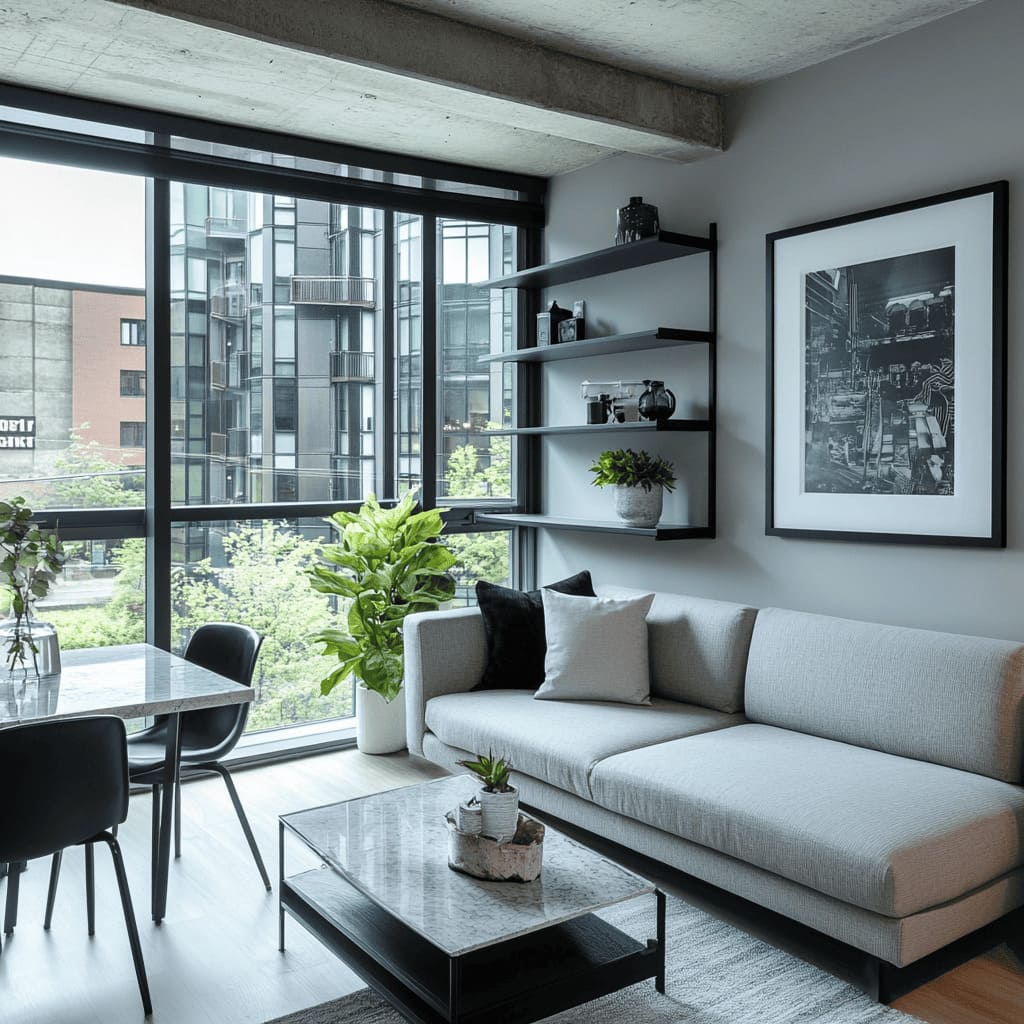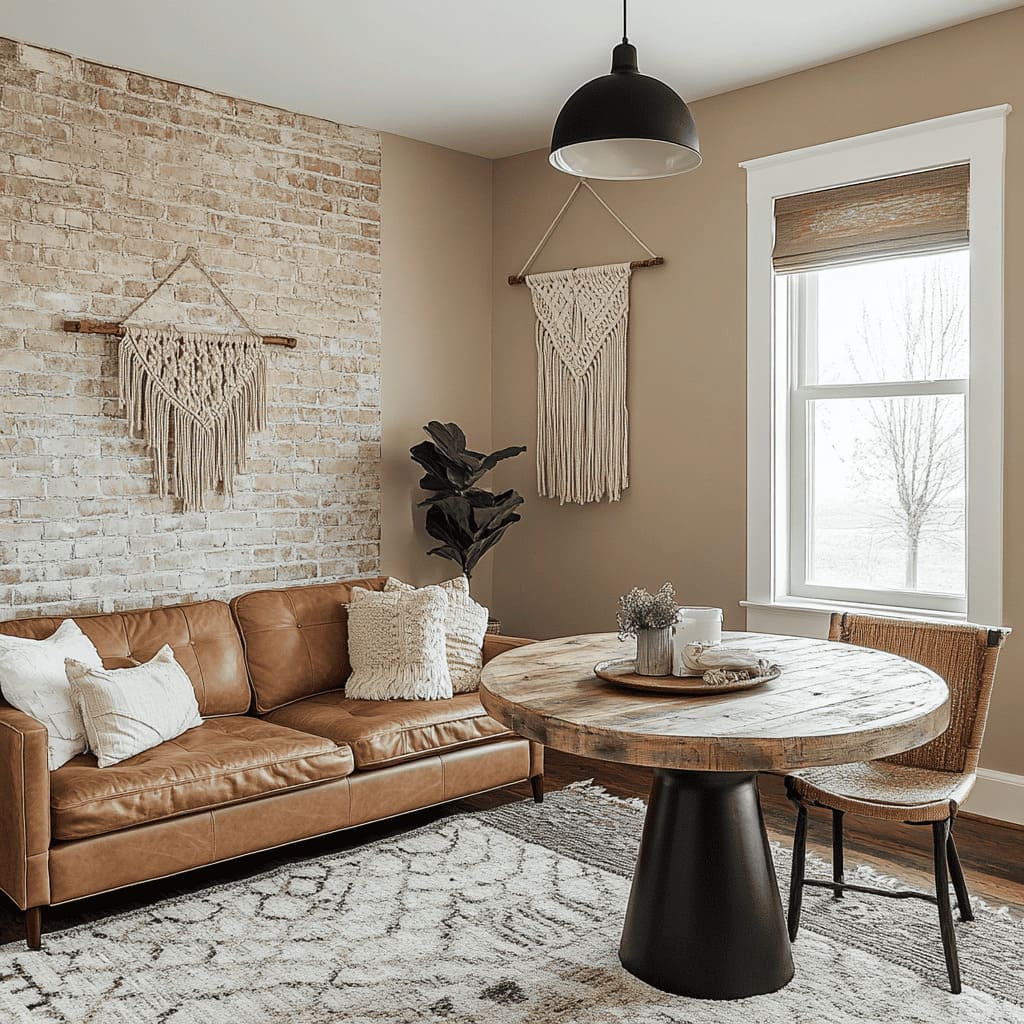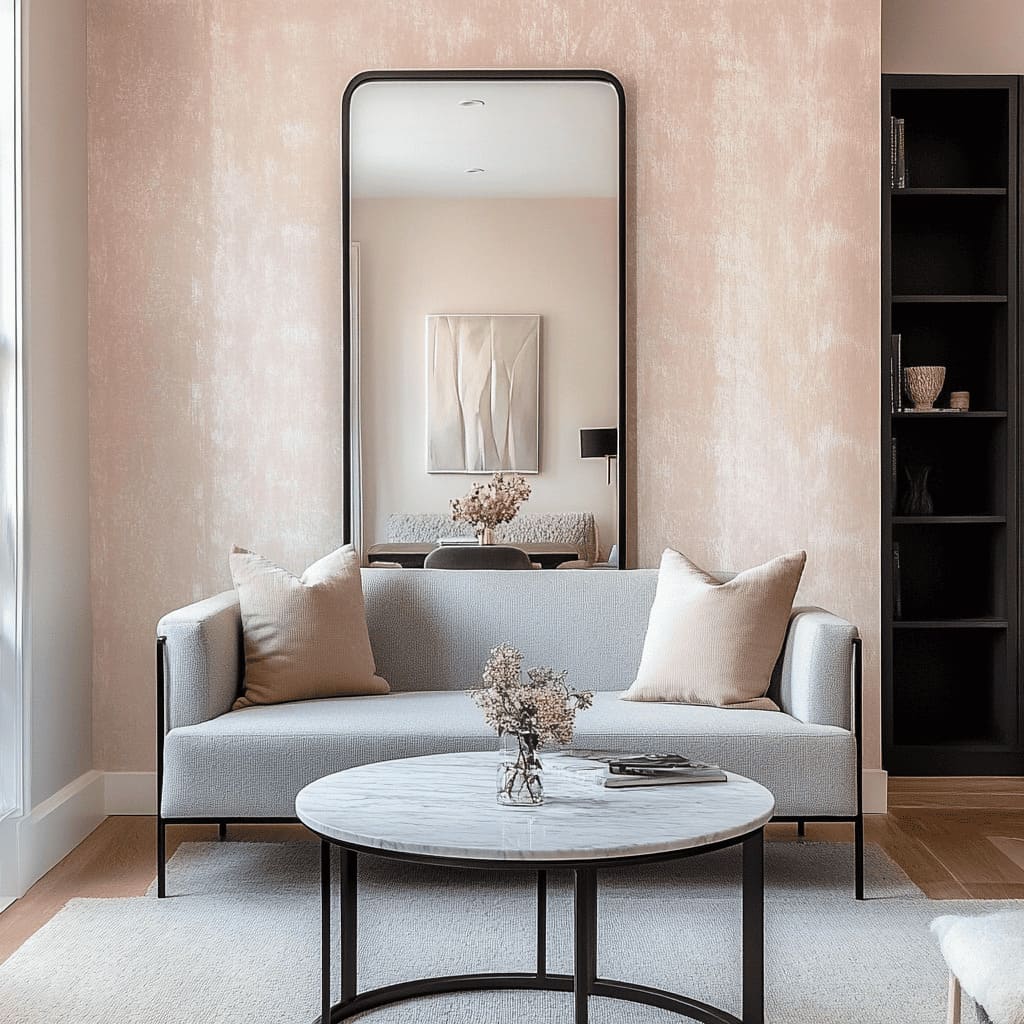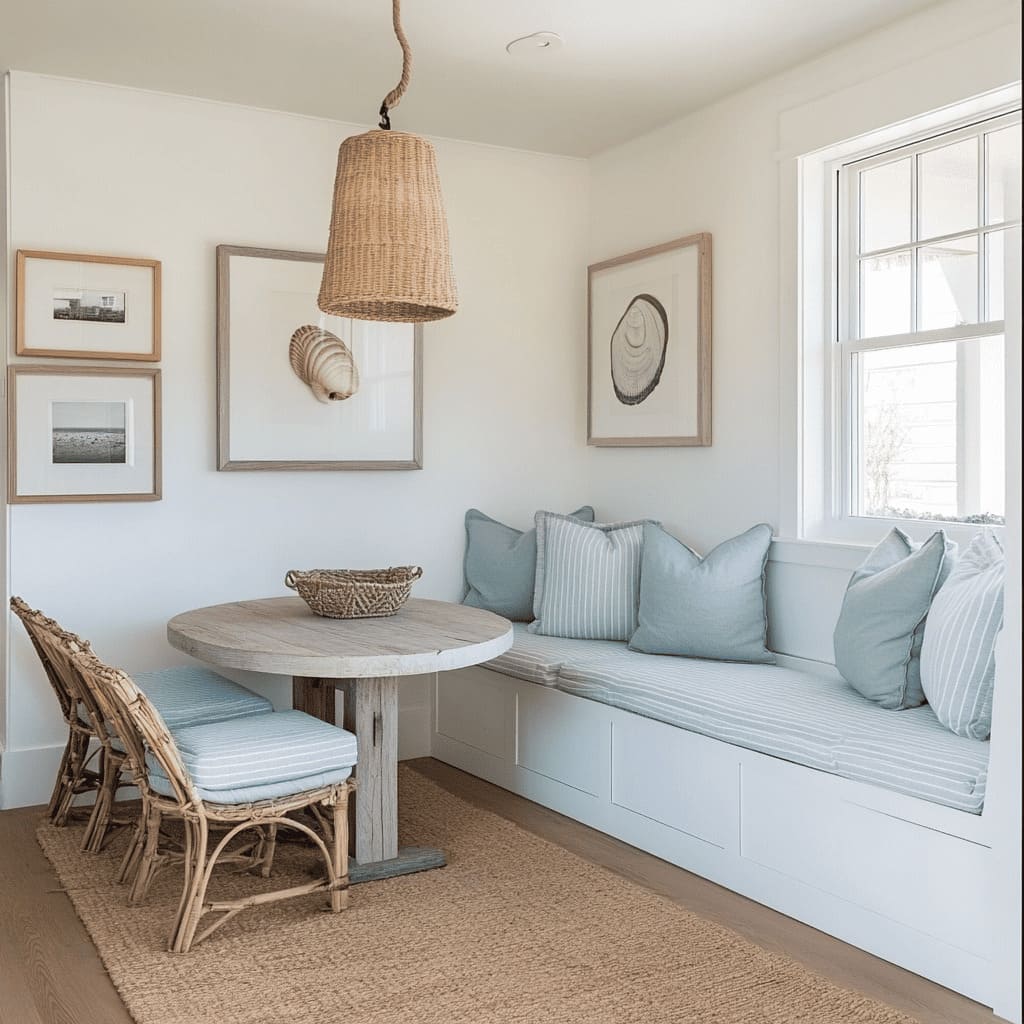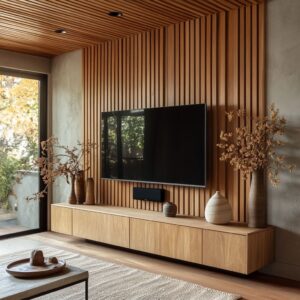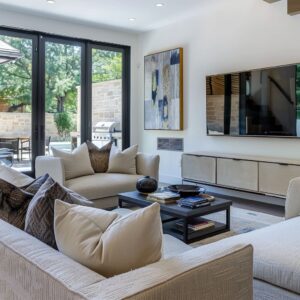Creating a cozy and functional living and dining room combo in a small space is both a delightful challenge and an opportunity to express personal style. American homes, whether quaint cottages, sleek townhouses, or charming bungalows, often feature these compact layouts.
The key is finding a balance between style and practicality—making every inch count while ensuring the space feels open and inviting. As homeowners increasingly seek ways to maximize their spaces, the need for creative solutions becomes more evident, especially when trying to blend two important areas of daily life.
This article delves into a range of ideas for small living and dining room combos, exploring how different design styles and furniture choices can transform these compact spaces. From the rustic warmth of a farmhouse in Atlanta to the airy feel of a coastal cottage in Montauk, or the urban edge of a Brooklyn townhouse, we’ll explore how to create a modern and cozy atmosphere tailored to various American home types.
We cover everything from the essentials of space planning to specific small living room dining room combo layout ideas that make the most of these intimate spaces.
The purpose of this article is to provide readers with practical tips and design inspiration. Whether you’re drawn to a minimalist aesthetic, love the charm of rustic decor, or prefer an urban contemporary look, there’s something here for every taste.
The goal is to guide you in crafting a small living room dining room combo that fits not only your style but also the specific needs and layout of your home. Let’s explore these solutions and make every square foot work for you.
Key Considerations for Small Combos
Layout Optimization
The first step in creating a small living and dining room combo is to carefully plan the layout. Without a thoughtful arrangement, the space can easily feel cramped or disconnected.
A successful layout doesn’t just divide the areas; it connects them seamlessly while providing enough room for movement and comfort. It’s crucial to visualize how the space will function daily, considering factors like flow, light, and accessibility.
One popular approach is to position the living room seating and dining area near a window. This not only allows for natural light to brighten both spaces but also provides a scenic spot for dining.
An L-shaped sofa is another smart option, as it helps define the living area while leaving room for a small dining table along one wall. The key is to choose pieces that fit the proportions of the room and don’t overpower the available space.
Built-in benches in the dining area can also be a clever way to maximize space; they offer both seating and storage, making them a practical choice in a small living room dining room combo.
Furniture Selection for Compact Spaces
Choosing the right furniture is essential when designing a small living and dining room combo. The pieces you select should enhance the flow between the two spaces rather than block it.
Modular sofas are a great choice—they can be reconfigured depending on your needs, providing flexibility for different occasions. For dining areas, consider foldable tables or extendable options that can expand when needed and tuck away when not in use, saving precious space.
Multi-purpose furniture is another game-changer. A coffee table with built-in storage or a bench that doubles as a seat and a storage unit can significantly enhance the functionality of a small space.
Additionally, selecting lightweight pieces that are easy to move allows you to rearrange the space with ease, adapting it to different uses throughout the day. With careful planning and the right furniture, a small living room dining room combo can feel spacious and inviting, offering both comfort and style without compromising on practicality.
Style Inspiration: Cozy and Modern Design Ideas
Coastal Charm in Cottages
Coastal design is all about capturing a light, breezy atmosphere that feels fresh and inviting. For cottages, the goal is to create a cozy escape that feels directly connected to the sea.
Slipcovered loveseats in shades of white or soft blues are an excellent starting point, as they are not only comfortable but also easy to maintain. Pair these with weathered wood coffee tables to introduce a natural, relaxed feel that mimics driftwood found along the shore.
To further enhance the coastal vibe, light, airy color palettes work best. Think whites, soft greys, and sandy beiges.
This approach keeps the space feeling open and airy, crucial in smaller settings where the living room and dining room combo needs to feel as spacious as possible. Accessories are where you can lean into the nautical theme—striped cushions, rope pendant lights, and jute rugs all bring a sense of the beach indoors.
A jute rug, for example, offers a textural element that is both durable and visually ties together the sitting area and dining nook, giving a unified, beachy look.
Rustic Elegance in Craftsman Homes
Craftsman homes are perfect for those who want to bring in a warm, rustic touch. These homes often feature rich wood finishes and traditional details that make them feel timeless.
For a small dining living room combo in these spaces, using spindle-back chairs and a reclaimed wood table is an easy way to infuse rustic charm. These classic pieces work well in compact layouts and provide a cohesive, unified look that feels natural to the architecture of a Craftsman home.
To create a cozy atmosphere, opt for deep, earthy tones like forest green sofas or burgundy armchairs. These colors add depth and warmth, making the space feel inviting.
Lighting plays an important role, too—brass sconces mounted on the walls offer a warm glow that enhances the intimate feel of the space. Built-in shelving is another hallmark of Craftsman design, providing both function and style.
Displaying ceramics, books, or potted plants on these shelves helps personalize the space, giving the combo area character and a lived-in look.
Modern Urban Style in Townhouses and Condos
For urban settings like Dallas, a modern style that embraces sleek lines and bold accents is ideal for small spaces. When working with a townhouse or condo, furniture with a minimalist profile is essential.
Streamlined sofas in neutral tones—like grey or black—paired with glass coffee tables create an open and airy feel, perfect for a small layout. These choices prevent the space from feeling overcrowded and allow for a clear, unobstructed flow between the dining and living areas.
When decorating these spaces, using bold accent walls can add visual depth. For instance, a deep blue or dark green wall behind the dining area can create a focal point that separates the two zones without needing physical dividers.
Floating shelves are a practical and stylish addition, providing room for books and decor items while keeping the floor space clear. Geometric rugs, on the other hand, can help ground the room, defining the living area and adding a modern touch that ties the whole space together.
Bohemian and Eclectic Mixes for Bungalows
Bungalows thrive on an eclectic, bohemian aesthetic that feels relaxed and full of personality. For small spaces, this style works beautifully, as it allows for flexibility and creativity.
Mixing and matching colors, patterns, and textures can turn a compact area into a warm and inviting spot. Start with a vintage-inspired loveseat in a rich color, like teal or mustard, and layer it with patterned pillows.
This sets the tone for a cozy and dynamic living space. Incorporate macramé wall hangings and potted plants to add a natural, boho vibe that complements both the living and dining areas.
Using potted plants as decor not only enhances the aesthetic but also brings life into the space, making it feel vibrant and fresh. For the dining area, mismatched chairs around a small round table can create a sense of casual charm.
The idea is to make the space feel collected and comfortable, where everything has a story. A colorful area rug can further unite the spaces, adding texture and warmth to an otherwise small footprint.
Scandinavian Minimalism in Tiny Homes and Cottages
Scandinavian style is perfect for tiny homes and cottages, where simplicity and functionality go hand in hand. The focus here is on clean lines, light wood finishes, and a minimal approach to decor, all of which help create a sense of openness even in the smallest of spaces.
For a sitting room dining room combo, opt for furniture that serves multiple purposes—like a small dining table that doubles as a workspace or a sofa with hidden storage. Light wood finishes, such as oak or birch, bring warmth without overwhelming the room.
Neutral color palettes—think whites, soft greys, and light beige—keep the area bright, reflecting natural light and making the space feel larger. Simple textiles, like cotton or linen throws, add softness, while avoiding heavy patterns keeps the overall look cohesive.
Incorporating large windows or mirrors enhances the light further, ensuring the tiny living and dining areas feel connected and open. With careful curation, even the smallest of spaces can achieve a cozy, modern Scandinavian look that feels effortlessly stylish.
Functional Elements: Design Tricks to Maximize Space
Designing a dining room living room combination that feels spacious and inviting requires careful consideration of each element in the room. With the right approach, it’s possible to maintain a sense of openness while still defining each area’s function.
Below are some effective strategies for making the most of a small living and dining room combo.
Clever Use of Dividers and Shelving
Creating a sense of separation between the living and dining areas without building walls is key to keeping the space open and flowing. Partial dividers and open shelving units are excellent tools for this purpose.
Instead of cutting off the view, they provide a subtle boundary that helps organize the space without making it feel cramped. Open shelving units can serve a dual purpose.
They act as storage while offering a display space for books, plants, and decorative items, adding both function and a touch of personality. These shelves also draw the eye upwards, which is essential in compact spaces as it creates an illusion of height.
Floating shelves, in particular, are great for adding interest without taking up floor space. They allow you to place decorative objects at different levels, enhancing the visual appeal of the room.
These small tricks help maintain an open, airy feeling while subtly marking the boundaries between the living and dining zones.
Lighting Solutions for a Cozy Ambiance
Lighting is a powerful tool in small spaces, especially when crafting a cozy atmosphere in a dining room living room combination. The right lighting choices not only brighten the room but also define and enhance different areas.
Pendant lights positioned above the dining table create a focal point and help to visually anchor the dining area. This approach draws attention to the dining spot, making it feel distinct from the living area.
Wall sconces are another option, offering gentle illumination without taking up valuable floor or table space. These can be positioned to highlight art or decor, adding dimension and warmth to the room.
Additionally, using string lights along shelves or around windows can introduce a soft glow, perfect for creating an inviting feel in the evenings. Mirrors play an equally important role—they bounce light around the room, making it feel larger and more open.
A well-placed mirror opposite a window can maximize natural light, while also giving the impression of extended space, which is crucial in compact settings.
Rugs and Textiles: Defining and Connecting Spaces
Rugs are more than just decorative items; they play a significant role in dividing and unifying small spaces. In a design living room and dining room combo, the right choice of rugs can help differentiate the areas while still keeping them visually connected.
For example, placing a large rug under the sofa and a smaller one beneath the dining table can clearly mark each zone without the need for physical dividers. The choice of material and pattern is important, too.
Persian rugs bring elegance and a touch of tradition, making them ideal for a living area that aims for a refined look. On the other hand, jute rugs work perfectly in coastal or bohemian spaces, providing a relaxed, natural feel that suits both living and dining spots.
Layering rugs with other textiles, such as throw blankets and cushions, adds texture and warmth, giving the room a welcoming vibe. This technique not only defines the areas but also ties them together harmoniously, making the combination feel cohesive and thoughtfully designed.
Flexible and Multifunctional Furniture Options
In small spaces, multifunctional furniture is essential for maximizing usability without compromising style. Foldable tables are a perfect example—these can be expanded when needed for dining and easily stored away, freeing up space when not in use.
Similarly, modular sofas provide the flexibility to adapt the layout, whether you want to create a cozy movie-watching area or open up the space for guests. Storage ottomans are another practical solution, offering both seating and storage for blankets, books, or other items.
These pieces help maintain a clutter-free environment, which is crucial in compact rooms. Lightweight and stackable chairs are excellent for small dining spaces; they can be moved around easily or stacked away when not needed, providing flexibility while keeping the space feeling open.
By choosing such versatile pieces, you can effortlessly transition your dining living room combo into a dynamic area that serves multiple purposes, fitting your lifestyle and needs. These decorating ideas for living room and dining room combos emphasize the importance of adaptability and thoughtful design choices, ensuring that small spaces remain functional, cozy, and stylish.
Style by Home Type: Tailored Ideas for Various American Homes
Designing small living and dining spaces requires a nuanced approach based on the architectural style of your home. What works in a Victorian duplex may not suit a ranch-style house or coastal cottage, but with thoughtful design, you can create a harmonious, functional combo no matter your home’s type.
Here’s a breakdown of ideas tailored to specific American home styles.
Victorian Homes and Duplexes
Victorian homes and duplexes often come with rich architectural details like crown moldings, wainscoting, and intricate woodwork. When decorating a small dining room living room combo in such a space, it’s important to strike a balance between honoring these traditional elements and infusing modern touches to keep the room feeling fresh.
A tufted loveseat in deep jewel tones, like emerald or sapphire, blends beautifully with the ornate features of a Victorian home while maintaining a contemporary vibe. Pair this classic piece with modern art—abstract prints or large-scale photography—to give the room a more updated, curated look.
For the dining area, consider an antique table paired with minimalist, modern chairs to create an interesting contrast. This blend of old and new adds character without overwhelming the small space.
Using accent wallpaper, such as a floral or damask pattern, on one wall or wainscoting throughout the room, can further highlight the historical charm. The goal is to keep the space grounded in its Victorian roots while introducing elements that make the room feel relevant to today’s design trends.
Ranch-Style and Mid-Century Modern Houses
Ranch-style and mid-century modern homes are known for their clean lines, open layouts, and a connection to nature through large windows or sliding doors. For a small dining room and living room combo, embrace the mid-century aesthetic with furniture that has simple, sleek shapes.
A mustard-colored sofa, for instance, brings a bold pop of retro style while still keeping the atmosphere warm and cozy. Pair the sofa with a low teak coffee table and a vintage floor lamp with a brass finish for that perfect touch of nostalgia.
These homes often feature open-plan layouts, so incorporating a dining area within the living space should feel seamless. Utilize a corner nook by placing a round dining table and a set of slim-profile chairs.
This setup works particularly well in small spaces as it keeps everything fluid and integrated. Modular setups, such as a sectional sofa that can be rearranged, are ideal for these homes, as they provide flexibility and allow you to adapt the space based on the occasion, whether for family gatherings or casual meals.
Cape Cod and Coastal Cottages
Cape Cod homes and coastal cottages naturally lean into light, airy designs. The focus here is on making the space feel bright and open, and the design choices should reflect a breezy, seaside vibe.
To achieve this in a small dining room and living room combo, use shiplap walls to bring a touch of coastal texture and charm. Whitewashed furniture, like a distressed wood coffee table or a white slipcovered sofa, keeps the palette light and fresh, perfect for a compact setting.
For decor, nautical-themed accents such as striped cushions, seashell-framed mirrors, and driftwood-inspired lighting fixtures bring the coast indoors. Since these homes often rely on a lot of natural light, using light-colored textiles, like linen curtains or jute rugs, can help amplify the room’s airiness.
A nautical-blue dining table with slim white chairs can complement the design while providing a practical place for meals, without making the room feel too busy. In these homes, keeping things light and using natural materials is key to maintaining an open, cohesive look.
Urban Condos and Modern Apartments
When working with a small dining room living room combo in an urban setting like condos or apartments, efficiency and sleek design are top priorities. The minimalist aesthetic works best in these spaces, where every piece needs to serve a function without overwhelming the room.
Stick to clean lines and space-saving furniture, like a compact sectional sofa in a neutral color paired with a glass coffee table. This keeps the living area feeling open and uncluttered.
For the dining section, opt for a small round or square table that can seat two to four people comfortably. Floating shelves on the walls can add storage and display space without taking up floor area, making the room feel more expansive.
Bold accent walls in darker hues, like navy or charcoal, help visually separate the dining and living spaces without the need for physical dividers. This creates depth and interest in the room.
Floating storage units are another practical addition, offering a sleek solution for hiding away clutter while keeping the space functional and stylish. Urban condos and modern apartments benefit greatly from these space-efficient, minimalist approaches that maximize every inch of the layout.
In each of these home styles, the key is to create a family room and dining room combo that respects the architectural personality of the home while introducing modern elements that enhance the functionality of the space. Whether it’s blending antique and contemporary designs in a Victorian duplex, or keeping things light and coastal in a Cape Cod cottage, small spaces don’t have to sacrifice style.
With thoughtful choices, your home can feel both cozy and modern, tailored to its unique character and layout.
Accessories and Finishing Touches for a Cohesive Look
Creating a unified and inviting small living room and dining room combined space comes down to the finishing touches. Accessories and decor play a crucial role in tying together the overall design, enhancing the sense of depth, and making the area feel complete.
Here’s how you can make the most of these elements.
Wall Art and Mirrors
In small spaces, mirrors are more than just practical—they can transform a room. A large mirror positioned strategically, such as opposite a window or above a console, reflects natural light, making the area feel brighter and more expansive.
This trick is especially useful for small living room and dining room combinations where creating the illusion of space is key.
Artwork, on the other hand, brings personality to the space. Framed botanical prints add a natural touch that pairs well with various styles, from rustic to modern.
Alternatively, abstract pieces can introduce bold colors and shapes, providing a contemporary vibe. When hanging wall art, consider placing a larger piece above the sofa or behind the dining table to serve as a focal point.
Group smaller pieces together to create a gallery effect, uniting the living and dining areas visually. This approach not only adds interest but also keeps the eye moving, making the space feel dynamic and cohesive.
Greenery and Natural Elements
Adding plants is one of the easiest ways to bring life and texture into a small space. Greenery like potted palms, hanging ferns, or small succulents can transform the atmosphere of a room, making it feel fresh and vibrant.
In small dining room and living room combos, plants can act as natural dividers, subtly separating the two spaces while still connecting them through their organic presence. For those who prefer low-maintenance options, succulents and snake plants are great choices.
They thrive in various lighting conditions and require minimal upkeep, making them ideal for urban apartments or townhouses where natural light may be limited. In spaces with more light, potted palms or fiddle-leaf figs work well, adding height and a sense of structure.
Hanging planters can also be used to draw the eye upward, maximizing vertical space and enhancing the room’s overall layout. Greenery adds a lively, natural element that complements any style, from coastal to contemporary.
Color Palette Suggestions for Small Spaces
Choosing the right color palette is crucial when decorating a small living room and dining room combo. The right hues can either open up the space or, if used incorrectly, make it feel even smaller.
For a cozy and welcoming feel, warm neutrals like beige, taupe, and soft browns work beautifully. These colors provide a versatile base that pairs well with a variety of accent shades, such as terracotta or deep olive, which can be introduced through cushions, throws, or rugs.
If you’re aiming for a bolder look, deep blues or forest greens create a moody, intimate atmosphere that feels sophisticated. These colors work particularly well in small dining areas, where they can add depth and richness without overwhelming the space.
To keep things balanced, pair these darker tones with lighter textiles, such as white or cream curtains, to maintain a sense of brightness. For those who prefer an airy, open look, light pastels and soft greys are ideal.
These shades reflect light and keep the space feeling bright, perfect for a coastal or Scandinavian-inspired layout. Layering these light tones with natural textures—like woven baskets, jute rugs, or linen pillows—adds warmth and prevents the room from feeling too clinical.
The key is to use color and texture thoughtfully to build depth and create a seamless flow between the living and dining areas.
Conclusion
In summary, there are countless ways to style small living and dining room combinations, whether you’re drawn to coastal charm, rustic elegance, or modern minimalism. By tailoring the approach to fit the architectural style of your home, you can create a space that feels both functional and beautifully designed.
Mixing modern touches with classic elements, or blending light and airy palettes with natural textures, offers endless possibilities for creating a warm, welcoming environment. No matter the style, it’s essential to personalize your space.
Don’t be afraid to mix and match ideas, layering pieces and colors that resonate with you. Your space should feel like an extension of your personality, reflecting your tastes and the way you live.
One final tip: when working with decorating ideas for dining room living room combos, start with a neutral foundation. Build layers with color, texture, and decor, gradually adding those personalized touches that make your small space truly feel like home.


